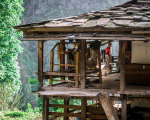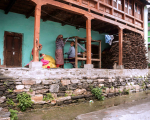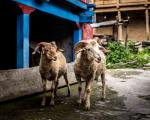I first stepped into the quaint village of Grahan in May 2014. Grahan is peacefully tucked away in the Parvati Valley, situated along the banks of the eponymous Parvati River in Kullu district. Nestled amidst the Western Himalayas, Parvati Valley is one of the most scenic valleys in Himachal Pradesh. Perennial snow covers the high peaks, and conifers like deodar and kaayal grow on the lower heights. The valley is traversed by a number of rivers and streams, and dotted by small villages which mainly sustain themselves on occupations like agriculture, forestry, animal husbandry, handloom activity and the financially-rewarding up-and-coming tourism businesses. Grahan village is accessible via Bhuntar and reveals itself only towards the end of a 10 km hike from Kasol.
Life in the high Himalayas is tough. The agricultural season is short, limited to the few summer months. This is a busy time for everyone in the household and involves plenty of outdoor work. During this period, when tourism is at its peak, majority of the men occupy themselves with trekking businesses in the higher summits or cater to their tourism businesses in towns like Kullu and Manali. In comparison, the winter months are idler; the household stays together and the women have comparatively more time to engage in weaving-related activities. Weaving is a skill particularly important to survive the extreme cold climate of the region. In the past, when there was little connectivity by road and access to markets, the remotely-located Grahanis produced all the daily necessities of life from local resources, including the textile which was sourced and produced locally. From sourcing of raw material to handcrafting the tools and usage of the finished garments, the people of Grahan managed it all on their own.
My journey of studying the self-sustaining local culture of Grahan was initiated five years ago. I was fascinated by their textile culture, particularly the craft of weaving pattu and kharcha. Nisha and Diya, two of my acquaintances in Parvati Valley, taught me the intricacies of weaving. Nisha bhabhi narrated the importance of wool in their pahadi lives. ‘Wool is believed to be innately pure being created by no less than our devata, Yagya Valkya Rishi and Mahamaaya. During shraaddha ceremony, a ritual related to the death, a woollen thread is placed over the pinda (millet balls offered to the dead). On all ceremonial occasions, wool is the only fabric prescribed by our devata and hence we wear the pattu while men wear khuthi on these days.’
Once I began interacting with the weavers, I started to learn the craft of pattu weaving from them and acquainted myself with the traditional raw materials, terms and techniques involved. Pattu is an apparel widely worn by the women folk in Kullu and Kinnaur districts of Himachal Pradesh. It is draped like a saree but instead of taking the end only over one shoulder, both the ends of the pattu are pinned just below the shoulder on the front side with silver pins/broaches (locally called boomani) joined with a long silver chain. Pattu is tied around the waist with a piece of cloth called gachhi (belt); kharcha on the other hand is a woollen fabric woven as a body covering for men and made into coats called khuthi.
Often when Nisha and Diya bhabhi were busy catering to the visiting tourists, I took the opportunity to practice the craft. The locals were amused by the sight of me weaving. While I wove, young girls would be glued to me while many villagers would stop by in the verandah to share a word of advice or a story related to the craft. The nuances of the craft have been traditionally preserved through such informal intergenerational oral transmission. I was not only keen on documenting the subject photographically but was also learning about it by doing it myself. This gave me not only a hands-on experience of learning how to weave but also an understanding of the challenges faced by the people of Grahan in ensuring the continuity of the craft.
Grahan’s increasing popularity amongst the tourists and the resultant exposure to the outside world has brought in changes to the lifestyle of the locals. Earlier, it was expected of every girl of marriageable age to know weaving and be able to weave their own pattu. Skill in weaving was expected and appreciated by the family of the prospective groom. However, there has been a gradual shift from traditional occupations, like agriculture and animal husbandry, to tourism. The ever-increasing tourism footfall has resulted in quick economic upliftment in the villagers’ earnings, allowing affordability of readymade garments from bigger markets. This has impacted the availability of raw material which was primarily sourced from local sheep. Nowadays, cheaper alternatives are readily available in the big cities and most of the yarn in the markets of Kullu and Bhuntar are imported from outside the village. Moreover, mobile connectivity and satellite television expose the youth to outside trends which they assimilate and then aspire to wear, preferring them over their traditional woollen garments. All these factors contribute to the decline of weaving as a craft.
In order to promote weaving in Kullu, cooperative societies like Bhuttico have set up training centres where weavers from the nearby villages live and work. However, the technical knowledge imparted here is symptomatic of the industrialisation of the craft. While it is true that cooperatives take care of tangible needs of craftspeople—like getting access to wider markets, getting paid regularly and better training facilities—they also detach them from their natural working environment and the generational learning process. The intangible inputs that an artist gets from their social environment is lost; over time, the entire pedagogical process becomes highly mechanical. For the future survival of pattu weaving and the creative process behind it, it is important that the informal pedagogy—learnings from family members and within the social environment of a village—is maintained for future generations.

















